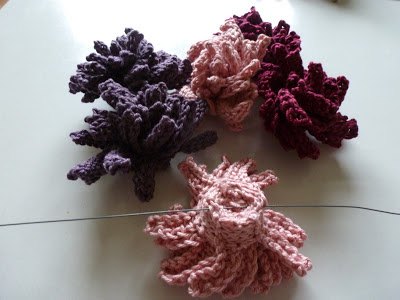Some decisions about the cake were very easy to make. We knew we wanted to have fruit cake with marzipan and icing. We knew we wanted three tiers. We knew that we were not going to buy it. I was all prepared to get making when I received some wonderful offers of help from my mum, my sister and my very creative friend. As very creative friend is artistic and has done a cake decorating course she was elected chief of cake and was put in charge.
My mum made the bottom layer and my sister made the middle layer, they marzipaned and iced them. The bottom layer took 12 hours to cook! Very creative friend made the top layer, the decorations, assembled the tiers and made an extra cake that I could take along to my knitting group. Big thanks to them all.
Each tier had navy grosgrain ribbon placed around it which was then decorated with knitted flowers. All I had managed to specify was that I wanted flowers in autumnal colours and I was amazed with what I got. I can not tell you how to knit the flowers as the pattern is very creative friends but you could use a pattern from the book mentioned in a previous post or just experiment and make one up. All the flowers had button centres and some had ribbon added too which gave a really lovely effect.
The flower placement on each tier was staggered which showed off all the flowers in their glory and also made it look a little less formal which was in keeping with the mood of our wedding. We decided that we wanted to keep the look quite simple so had matching flowers on the top of the cake.
Here you can see a close up of the flowers and a little bit of detail of the cake stand. It was an ornate silver 1920s cake stand which was totally gorgeous, I loved it. It was hired from the local bakers, what an object to own!
I wanted the cake to be on an embroidered tablecloth for several reasons. I love them and collect them. I like to imagine people sat in their living room embroidering little sections day by day. I like to think who those people may have been, who they were making it for, why they choose to use that particular transfer or that combination of colours. I like to look at the needlework and imagine someone making those stitches. I do not even mind if they have the odd stain as I wonder what it was and hope that they were having a good meal when it happened.
They also remind me of my grandma. She had a few such tablecloths that used to sometimes come out at tea time. There was always a chocolate cake on a cake plate and very often jelly in a big glass bowl. Grandma had a crinoline lady tablecloth which was my favourite. I have it now and pick up others when I see them. Sometimes we used the crinoline lady china set at the same time. My sister has that. The tablecloth used was not Grandmas as I did not want to worry about it on my wedding day. But I know she would have approved and it was a way of having her there in spirit.
If anyone knows why there seemed to be a crinoline lady obsession on tablecloths, napkins and china in the 1930s and 1940s do let me know.
One great thing about having three people each making one layer of the cake is that every layer is a different recipe. They all taste marvellous but not the same with variations in fruit, amount of fruit, type of sugar and type of alcohol used to soak the fruit or to feed the cake. We are enjoying having a cake to cut at and offer to guests. It is like a little piece of wedding joy every time.




































































